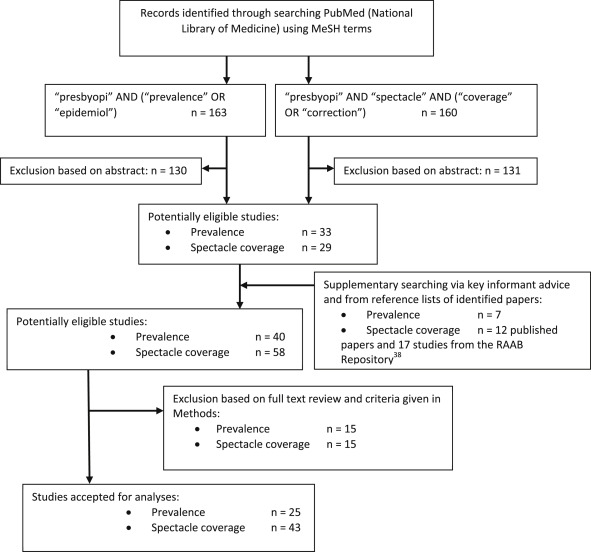Ophthalmology ( IF 13.7 ) Pub Date : 2018-05-09 , DOI: 10.1016/j.ophtha.2018.04.013 Timothy R. Fricke , Nina Tahhan , Serge Resnikoff , Eric Papas , Anthea Burnett , Suit May Ho , Thomas Naduvilath , Kovin S. Naidoo

|
Topic
Presbyopia prevalence and spectacle-correction coverage were estimated by systematic review and meta-analysis of epidemiologic evidence, then modeled to expand to country, region, and global estimates.
Clinical Relevance
Understanding presbyopia epidemiologic factors and correction coverage is critical to overcoming the burden of vision impairment (VI) from uncorrected presbyopia.
Methods
We performed systematic reviews of presbyopia prevalence and spectacle-correction coverage. Accepted presbyopia prevalence data were gathered into 5-year age groups from 0 to 90 years or older and meta-analyzed within World Health Organization global burden of disease regions. We developed a model based on amplitude of accommodation adjusted for myopia rates to match the regionally meta-analyzed presbyopia prevalence. Presbyopia spectacle-correction coverage was analyzed against country-level variables from the year of data collection; variation in correction coverage was described best by a model based on the Human Development Index, Gini coefficient, and health expenditure, with adjustments for age and urbanization. We used the models to estimate presbyopia prevalence and spectacle-correction coverage in each age group in urban and rural areas of every country in the world, and combined with population data to estimate the number of people with near VI.
Results
We estimate there were 1.8 billion people (prevalence, 25%; 95% confidence interval [CI], 1.7–2.0 billion [23%–27%]) globally with presbyopia in 2015, 826 million (95% CI, 686–960 million) of whom had near VI because they had no, or inadequate, vision correction. Global unmet need for presbyopia correction in 2015 is estimated to be 45% (95% CI, 41%–49%). People with presbyopia are more likely to have adequate optical correction if they live in an urban area of a more developed country with higher health expenditure and lower inequality.
Conclusions
There is a significant burden of VI from uncorrected presbyopia, with the greatest burden in rural areas of low-resource countries.
中文翻译:

未矫正的老花眼的老花眼和视力障碍的全球患病率
话题
通过对流行病学证据进行系统的回顾和荟萃分析,可以估算老花眼的患病率和矫正眼镜的覆盖率,然后将其建模以扩展到国家,地区和全球范围内的估算。
临床相关性
了解老花眼的流行病学因素和矫正覆盖范围对于克服未矫正的老花眼对视力损害(VI)的负担至关重要。
方法
我们对老花眼患病率和眼镜矫正覆盖率进行了系统评价。接受的老花眼患病率数据被收集到0岁至90岁之间的5岁年龄组中,并在世界卫生组织全球疾病负担区域内进行荟萃分析。我们根据适应幅度调整了近视率,以适应区域荟萃分析的老花眼患病率,我们开发了一个模型。根据数据收集年份的国家水平变量对老花眼眼镜矫正范围进行了分析;校正覆盖率的变化最好通过基于人类发展指数,基尼系数和卫生支出的模型进行描述,并根据年龄和城市化程度进行调整。
结果
我们估计,2015年全球有18亿人(老视率25%;置信区间[CI]为95%,1.7-20亿[23%-27%]),8.26亿(老挝,95%CI,686-9.6亿) )的视力矫正不佳或不足,因此他们的视力接近VI。2015年,全球未满足的老花眼矫正需求估计为45%(95%CI,41%–49%)。如果老花眼患者生活在医疗费用较高,不平等程度较低的发达国家的城市中,则更可能进行适当的光学矫正。
结论
未经矫正的老花眼会给VI带来很大负担,而在资源贫乏国家的农村地区,VI的负担最大。


























 京公网安备 11010802027423号
京公网安备 11010802027423号